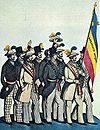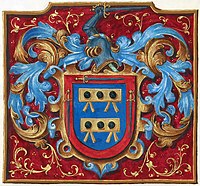Portal:Heraldry
Welcome to the Heraldry and Vexillology Portal!


Vexillology (from the Latin vexillum, a flag or banner) is the scholarly study of flags, including the creation and development of a body of knowledge about flags of all types, their forms and functions, and of scientific theories and principles based on that knowledge. Flags were originally used to assist military coordination on the battlefield, and have evolved into a general tool for signalling and identification, particularly identification of countries.
Heraldry encompasses all of the duties of a herald, including the science and art of designing, displaying, describing and recording coats of arms and badges, as well as the formal ceremonies and laws that regulate the use and inheritance of arms. The origins of heraldry lie in the medieval need to distinguish participants in battles or jousts, whose faces were hidden by steel helmets.
Selected coat of arms

The coat of arms of Albany, New York is a heraldic symbol representing the city of Albany, the capital of the U.S. state of New York. The coat of arms is rarely seen by itself; it is almost always used in the city seal or on the city flag. The current coat of arms was adopted in 1789, although prior to that it was significantly simpler, ranging from stylized lettering to a caricature of a beaver. Included in the coat of arms are references to Albany's agricultural and fur-trading past. It is supported by a white man and an American Indian and is crested by a sloop. The coat of arms is meant to represent the "symbols of industry and its rewards to man and beast on land and sea". (more...)
Selected flag

The colors of the national flag of Romania (Romanian: Drapelul României) have a long history. Red, yellow and blue were found on late 16th-century royal grants of Michael the Brave, as well as shields and banners. During the Wallachian uprising of 1821, they were present on the canvas of the revolutionaries' flag and its fringes; for the first time a meaning was attributed to them: "Liberty (sky-blue), Justice (field yellow), Fraternity (blood red)". Article 124 of the 1866 Constitution of Romania provided that “the colors of the United Principalities will be Blue, Yellow and Red”. The order and placement of the colors were decided by the Assembly of Deputies in its session of 26 March 1867. Thus, following a proposal by Nicolae Golescu, they were placed just as in 1848.
On 30 December 1947, Romania was proclaimed a people’s republic and all the kingdom’s symbols were outlawed, including the coats of arms and the tricolor flags that showed them. According to article 101 of the 1948 Constitution, “The flag of the Romanian People’s Republic is composed of the colors: blue, yellow and red, arranged vertically. In the middle is placed the national coat of arms”. (more...)
Selected article
Ireland King of Arms was the title of an Irish officer of arms from 1392 until the accession of Henry VII as King of England in 1485. The office was replaced in 1552 by that of Ulster King of Arms, which in 1943 was merged with Norroy King of Arms forming the present office of Norroy and Ulster King of Arms. In theory, Ireland King of Arms enjoyed heraldic jurisdiction in the whole of the Lordship of Ireland. (more...)
Selected picture
Illustration from a manuscript grant of arms by Philip II of Spain to Alonso de Mesa and Hernando de Mesa, signed 25 November 1566. Digitally restored.
Did you know...
- ...that the Dannebrog (pictured) is the oldest state flag in the world still in use, with the earliest undisputed source dating back to the 14th century?
- ...that Marcela de Agoncillo, who made the first flag of the Philippines, was married to the first Filipino diplomat?
- ...that the current rendering of the mermaid in the coat of arms of Ustka is the result of a two-year debate over the size of her breasts?
- ...that the Pennon, one of the principal varieties of flag carried during the Middle Ages, derives its name from the Latin penna, meaning wing?
Related portals
|
|
|
Heraldry Web resources
Authorities
- Belgium - The Council of Nobility, Flemish Heraldic Council and Council of Heraldry and Vexillology of the French Community
- Canada - Canadian Heraldic Authority and see also Public Register of Arms, Flags and Badges
- England, Wales, and Northern Ireland - The College of Arms
- Ireland - The Office of the Chief Herald of Ireland
- Netherlands - High Council of Nobility
- Portugal - Instituto da Nobreza Portuguesa
- Scotland - The Court of the Lord Lyon
- South Africa - South African Bureau of Heraldry
- Sweden - National Board of Heraldry, The National Archive
- United States Army - The United States Army Institute of Heraldry
Societies
- Greek Heraldry Society
- The Academy of Heraldic Science Czech republic
- The American College of Heraldry
- The American Heraldry Society
- The Augustan Society
- The Australian Heraldry Society Inc.
- Bulgarian Heraldry and Vexillology Society
- The Center for Research of Orthodox Monarchism
- Cambridge University Heraldic and Genealogical Society
- Chiltern Heraldry Group
- The College of Dracology
- Croatian Heraldic and Vexillologic Association
- The Finnish Heraldic Society
- Fryske Rie foar Heraldyk
- Hellenic Armigers Society
- Guild of Heraldic Artists
- Genealogical Society of Ireland
- Heraldry Research Institute (Japan)
- The Heraldry Society
- The Heraldry Society of Africa
- The Heraldry Society of New Zealand Inc.
- The Heraldry Society of Scotland
- The Heraldry Society of Southern Africa
- The Institute of Heraldic and Genealogical Studies
- The International Association of Amateur Heralds
- Italian Center of Vexillological Studies
- Lancashire Heraldry Group
- Macedonian Heraldry Society
- New England Historic Genealogical Society Committee on Heraldry
- Norwegian Heraldry Society
- Oxford University Heraldry Society
- Polish Heraldry Society
- Polish Nobility Confederation
- Real Academia Matritense de Heráldica y Genealogía - Royal Academy of Heraldry and Genealogy of Madrid
- Romanian Institute for Genealogy and Heraldry
- The Royal Heraldry Society of Canada
- The Russian College of HeraldryThe Russian College of Heraldry
- Serbian Heraldic Society
- Societas Heraldica Scandinavica
- Societas Heraldica Slovenica
- Swedish Heraldic Society
- Ukrainian Heraldry Society
- Royal Association Genealogical and Heraldic Office of Belgium
Vexillology
Software
- Coat of Arms Visual Designer web-based program
- Puncher Heraldry Program
- Blazonry Server - pyBlazon
- DrawShield - creates SVG shield or arms image from blazon
- CoaMaker - web-based tool
- Blazon95 and BLAZONS! 2000, older Windows applications
Texts
- Heraldry, historical and popular : with seven hundred illustrations (1863)
- A Complete Guide to Heraldry (1909)
Other
Wikimedia
The following Wikimedia Foundation sister projects provide more on this subject:
-
Commons
Free media repository -
Wikibooks
Free textbooks and manuals -
Wikidata
Free knowledge base -
Wikinews
Free-content news -
Wikiquote
Collection of quotations -
Wikisource
Free-content library -
Wikispecies
Directory of species -
Wikiversity
Free learning tools -
Wikivoyage
Free travel guide -
Wiktionary
Dictionary and thesaurus













